Analysis of Tourism Consumer Behavior and Decision Making
VerifiedAdded on 2023/01/19
|15
|4877
|43
Report
AI Summary
This report provides an in-depth analysis of tourism consumer behavior, focusing on factors influencing consumer choices and the decision-making process within the context of TUI Travel. It examines the impact of cultural, social, personal, and psychological factors on consumer attitudes and behaviors, as well as the changes brought about by digital technology. The report explores the stages of the consumer decision-making journey, mapping the path to purchase for tourism services and emphasizing the importance of understanding consumer behavior for marketers in the tourism sector. Furthermore, it compares and contrasts the hospitality decision-making process in B2C and B2B contexts, discussing different market research approaches. The report concludes by highlighting how marketers influence the various stages of the tourism decision-making process. The report provides valuable insights into consumer behavior and marketing strategies within the tourism industry.
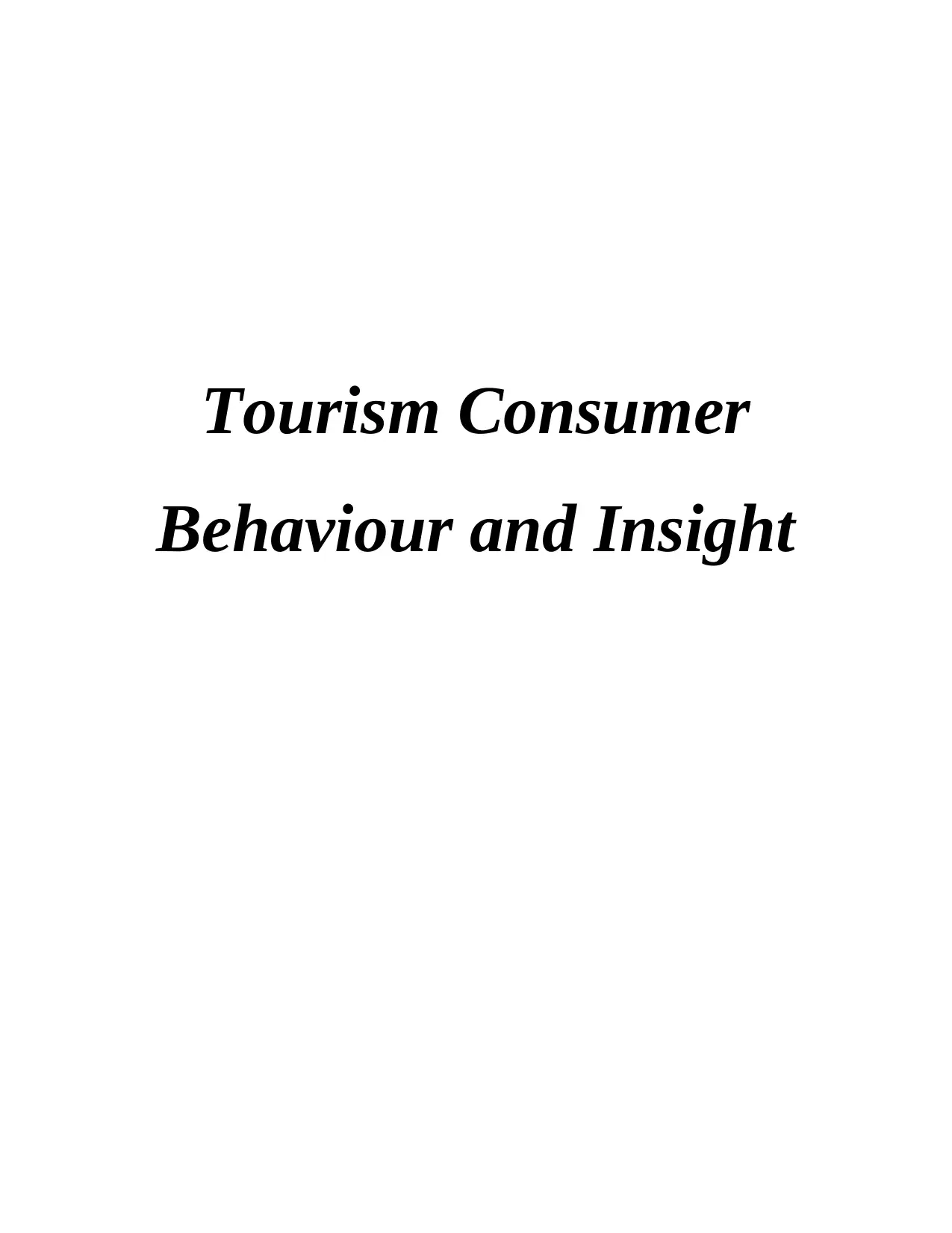
Tourism Consumer
Behaviour and Insight
Behaviour and Insight
Paraphrase This Document
Need a fresh take? Get an instant paraphrase of this document with our AI Paraphraser
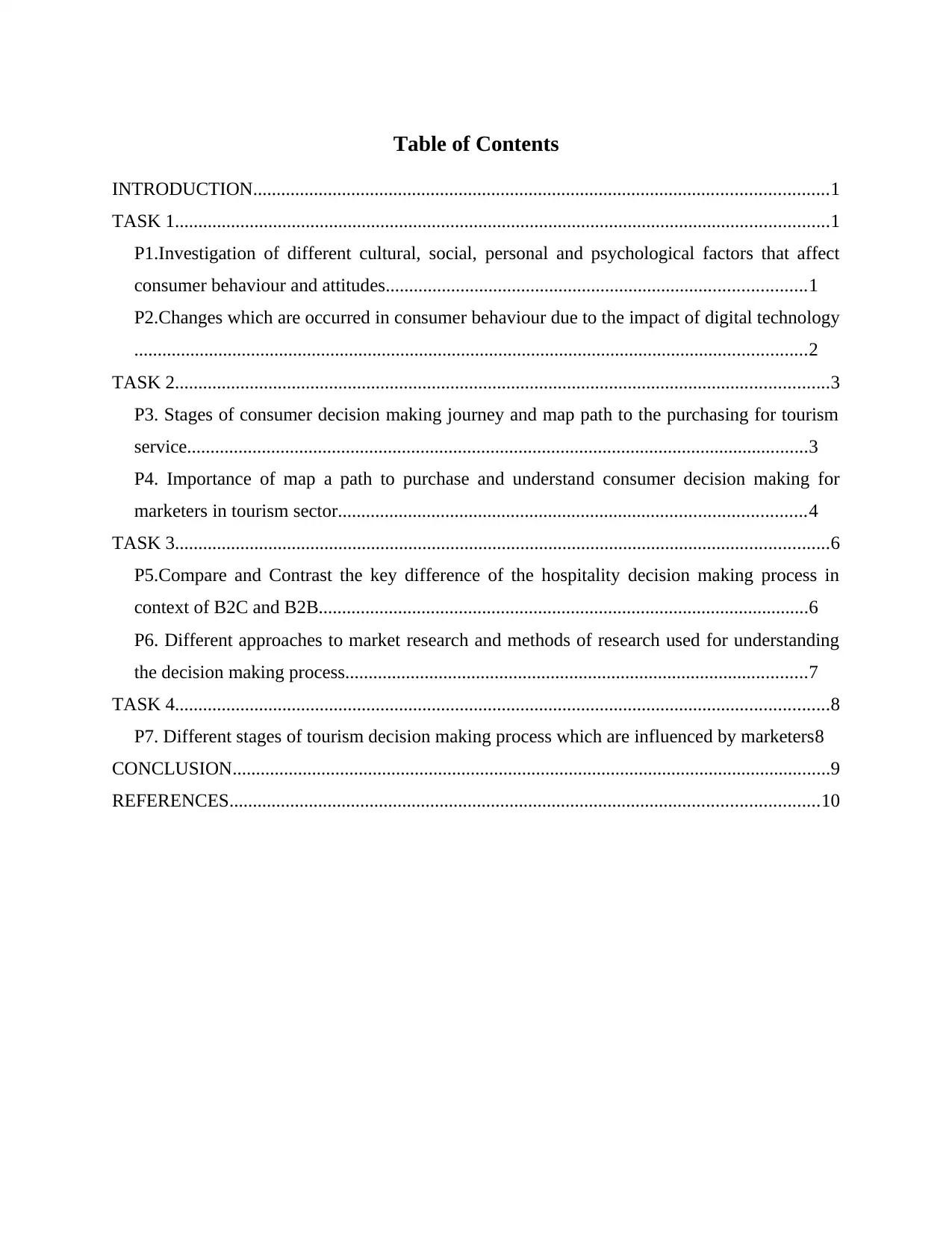
Table of Contents
INTRODUCTION...........................................................................................................................1
TASK 1............................................................................................................................................1
P1.Investigation of different cultural, social, personal and psychological factors that affect
consumer behaviour and attitudes..........................................................................................1
P2.Changes which are occurred in consumer behaviour due to the impact of digital technology
................................................................................................................................................2
TASK 2............................................................................................................................................3
P3. Stages of consumer decision making journey and map path to the purchasing for tourism
service.....................................................................................................................................3
P4. Importance of map a path to purchase and understand consumer decision making for
marketers in tourism sector....................................................................................................4
TASK 3............................................................................................................................................6
P5.Compare and Contrast the key difference of the hospitality decision making process in
context of B2C and B2B.........................................................................................................6
P6. Different approaches to market research and methods of research used for understanding
the decision making process...................................................................................................7
TASK 4............................................................................................................................................8
P7. Different stages of tourism decision making process which are influenced by marketers8
CONCLUSION................................................................................................................................9
REFERENCES..............................................................................................................................10
INTRODUCTION...........................................................................................................................1
TASK 1............................................................................................................................................1
P1.Investigation of different cultural, social, personal and psychological factors that affect
consumer behaviour and attitudes..........................................................................................1
P2.Changes which are occurred in consumer behaviour due to the impact of digital technology
................................................................................................................................................2
TASK 2............................................................................................................................................3
P3. Stages of consumer decision making journey and map path to the purchasing for tourism
service.....................................................................................................................................3
P4. Importance of map a path to purchase and understand consumer decision making for
marketers in tourism sector....................................................................................................4
TASK 3............................................................................................................................................6
P5.Compare and Contrast the key difference of the hospitality decision making process in
context of B2C and B2B.........................................................................................................6
P6. Different approaches to market research and methods of research used for understanding
the decision making process...................................................................................................7
TASK 4............................................................................................................................................8
P7. Different stages of tourism decision making process which are influenced by marketers8
CONCLUSION................................................................................................................................9
REFERENCES..............................................................................................................................10
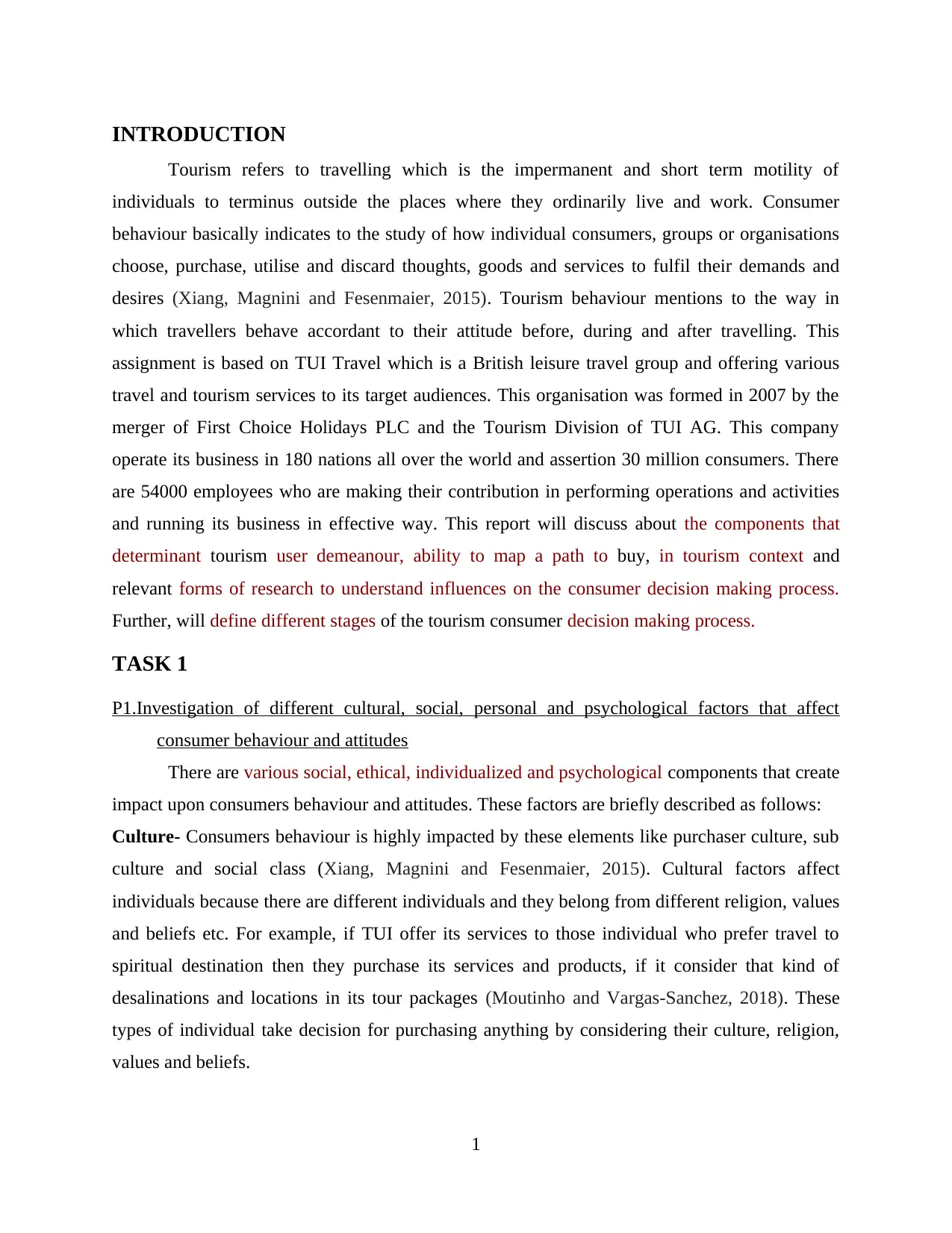
INTRODUCTION
Tourism refers to travelling which is the impermanent and short term motility of
individuals to terminus outside the places where they ordinarily live and work. Consumer
behaviour basically indicates to the study of how individual consumers, groups or organisations
choose, purchase, utilise and discard thoughts, goods and services to fulfil their demands and
desires (Xiang, Magnini and Fesenmaier, 2015). Tourism behaviour mentions to the way in
which travellers behave accordant to their attitude before, during and after travelling. This
assignment is based on TUI Travel which is a British leisure travel group and offering various
travel and tourism services to its target audiences. This organisation was formed in 2007 by the
merger of First Choice Holidays PLC and the Tourism Division of TUI AG. This company
operate its business in 180 nations all over the world and assertion 30 million consumers. There
are 54000 employees who are making their contribution in performing operations and activities
and running its business in effective way. This report will discuss about the components that
determinant tourism user demeanour, ability to map a path to buy, in tourism context and
relevant forms of research to understand influences on the consumer decision making process.
Further, will define different stages of the tourism consumer decision making process.
TASK 1
P1.Investigation of different cultural, social, personal and psychological factors that affect
consumer behaviour and attitudes
There are various social, ethical, individualized and psychological components that create
impact upon consumers behaviour and attitudes. These factors are briefly described as follows:
Culture- Consumers behaviour is highly impacted by these elements like purchaser culture, sub
culture and social class (Xiang, Magnini and Fesenmaier, 2015). Cultural factors affect
individuals because there are different individuals and they belong from different religion, values
and beliefs etc. For example, if TUI offer its services to those individual who prefer travel to
spiritual destination then they purchase its services and products, if it consider that kind of
desalinations and locations in its tour packages (Moutinho and Vargas-Sanchez, 2018). These
types of individual take decision for purchasing anything by considering their culture, religion,
values and beliefs.
1
Tourism refers to travelling which is the impermanent and short term motility of
individuals to terminus outside the places where they ordinarily live and work. Consumer
behaviour basically indicates to the study of how individual consumers, groups or organisations
choose, purchase, utilise and discard thoughts, goods and services to fulfil their demands and
desires (Xiang, Magnini and Fesenmaier, 2015). Tourism behaviour mentions to the way in
which travellers behave accordant to their attitude before, during and after travelling. This
assignment is based on TUI Travel which is a British leisure travel group and offering various
travel and tourism services to its target audiences. This organisation was formed in 2007 by the
merger of First Choice Holidays PLC and the Tourism Division of TUI AG. This company
operate its business in 180 nations all over the world and assertion 30 million consumers. There
are 54000 employees who are making their contribution in performing operations and activities
and running its business in effective way. This report will discuss about the components that
determinant tourism user demeanour, ability to map a path to buy, in tourism context and
relevant forms of research to understand influences on the consumer decision making process.
Further, will define different stages of the tourism consumer decision making process.
TASK 1
P1.Investigation of different cultural, social, personal and psychological factors that affect
consumer behaviour and attitudes
There are various social, ethical, individualized and psychological components that create
impact upon consumers behaviour and attitudes. These factors are briefly described as follows:
Culture- Consumers behaviour is highly impacted by these elements like purchaser culture, sub
culture and social class (Xiang, Magnini and Fesenmaier, 2015). Cultural factors affect
individuals because there are different individuals and they belong from different religion, values
and beliefs etc. For example, if TUI offer its services to those individual who prefer travel to
spiritual destination then they purchase its services and products, if it consider that kind of
desalinations and locations in its tour packages (Moutinho and Vargas-Sanchez, 2018). These
types of individual take decision for purchasing anything by considering their culture, religion,
values and beliefs.
1
⊘ This is a preview!⊘
Do you want full access?
Subscribe today to unlock all pages.

Trusted by 1+ million students worldwide
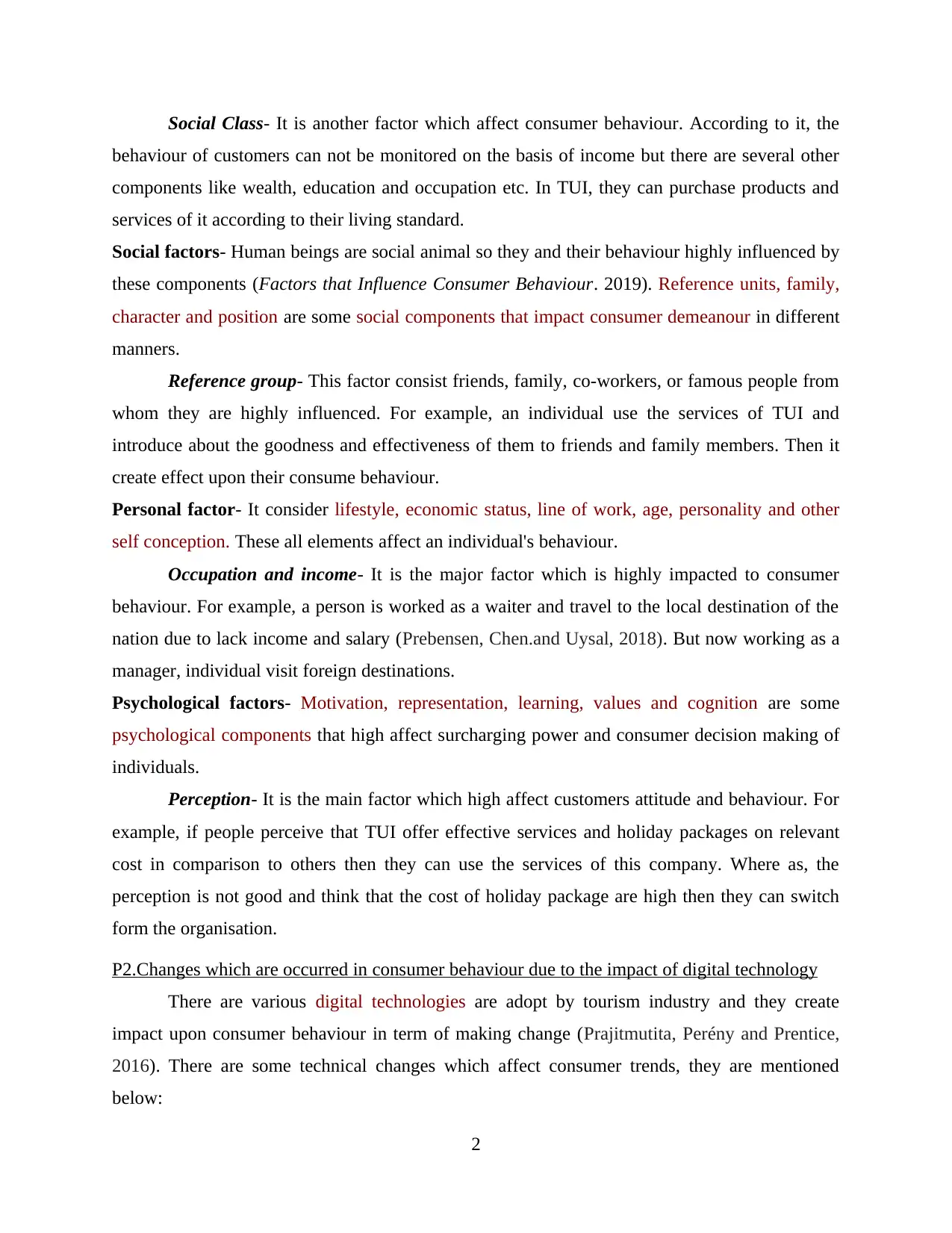
Social Class- It is another factor which affect consumer behaviour. According to it, the
behaviour of customers can not be monitored on the basis of income but there are several other
components like wealth, education and occupation etc. In TUI, they can purchase products and
services of it according to their living standard.
Social factors- Human beings are social animal so they and their behaviour highly influenced by
these components (Factors that Influence Consumer Behaviour. 2019). Reference units, family,
character and position are some social components that impact consumer demeanour in different
manners.
Reference group- This factor consist friends, family, co-workers, or famous people from
whom they are highly influenced. For example, an individual use the services of TUI and
introduce about the goodness and effectiveness of them to friends and family members. Then it
create effect upon their consume behaviour.
Personal factor- It consider lifestyle, economic status, line of work, age, personality and other
self conception. These all elements affect an individual's behaviour.
Occupation and income- It is the major factor which is highly impacted to consumer
behaviour. For example, a person is worked as a waiter and travel to the local destination of the
nation due to lack income and salary (Prebensen, Chen.and Uysal, 2018). But now working as a
manager, individual visit foreign destinations.
Psychological factors- Motivation, representation, learning, values and cognition are some
psychological components that high affect surcharging power and consumer decision making of
individuals.
Perception- It is the main factor which high affect customers attitude and behaviour. For
example, if people perceive that TUI offer effective services and holiday packages on relevant
cost in comparison to others then they can use the services of this company. Where as, the
perception is not good and think that the cost of holiday package are high then they can switch
form the organisation.
P2.Changes which are occurred in consumer behaviour due to the impact of digital technology
There are various digital technologies are adopt by tourism industry and they create
impact upon consumer behaviour in term of making change (Prajitmutita, Perény and Prentice,
2016). There are some technical changes which affect consumer trends, they are mentioned
below:
2
behaviour of customers can not be monitored on the basis of income but there are several other
components like wealth, education and occupation etc. In TUI, they can purchase products and
services of it according to their living standard.
Social factors- Human beings are social animal so they and their behaviour highly influenced by
these components (Factors that Influence Consumer Behaviour. 2019). Reference units, family,
character and position are some social components that impact consumer demeanour in different
manners.
Reference group- This factor consist friends, family, co-workers, or famous people from
whom they are highly influenced. For example, an individual use the services of TUI and
introduce about the goodness and effectiveness of them to friends and family members. Then it
create effect upon their consume behaviour.
Personal factor- It consider lifestyle, economic status, line of work, age, personality and other
self conception. These all elements affect an individual's behaviour.
Occupation and income- It is the major factor which is highly impacted to consumer
behaviour. For example, a person is worked as a waiter and travel to the local destination of the
nation due to lack income and salary (Prebensen, Chen.and Uysal, 2018). But now working as a
manager, individual visit foreign destinations.
Psychological factors- Motivation, representation, learning, values and cognition are some
psychological components that high affect surcharging power and consumer decision making of
individuals.
Perception- It is the main factor which high affect customers attitude and behaviour. For
example, if people perceive that TUI offer effective services and holiday packages on relevant
cost in comparison to others then they can use the services of this company. Where as, the
perception is not good and think that the cost of holiday package are high then they can switch
form the organisation.
P2.Changes which are occurred in consumer behaviour due to the impact of digital technology
There are various digital technologies are adopt by tourism industry and they create
impact upon consumer behaviour in term of making change (Prajitmutita, Perény and Prentice,
2016). There are some technical changes which affect consumer trends, they are mentioned
below:
2
Paraphrase This Document
Need a fresh take? Get an instant paraphrase of this document with our AI Paraphraser
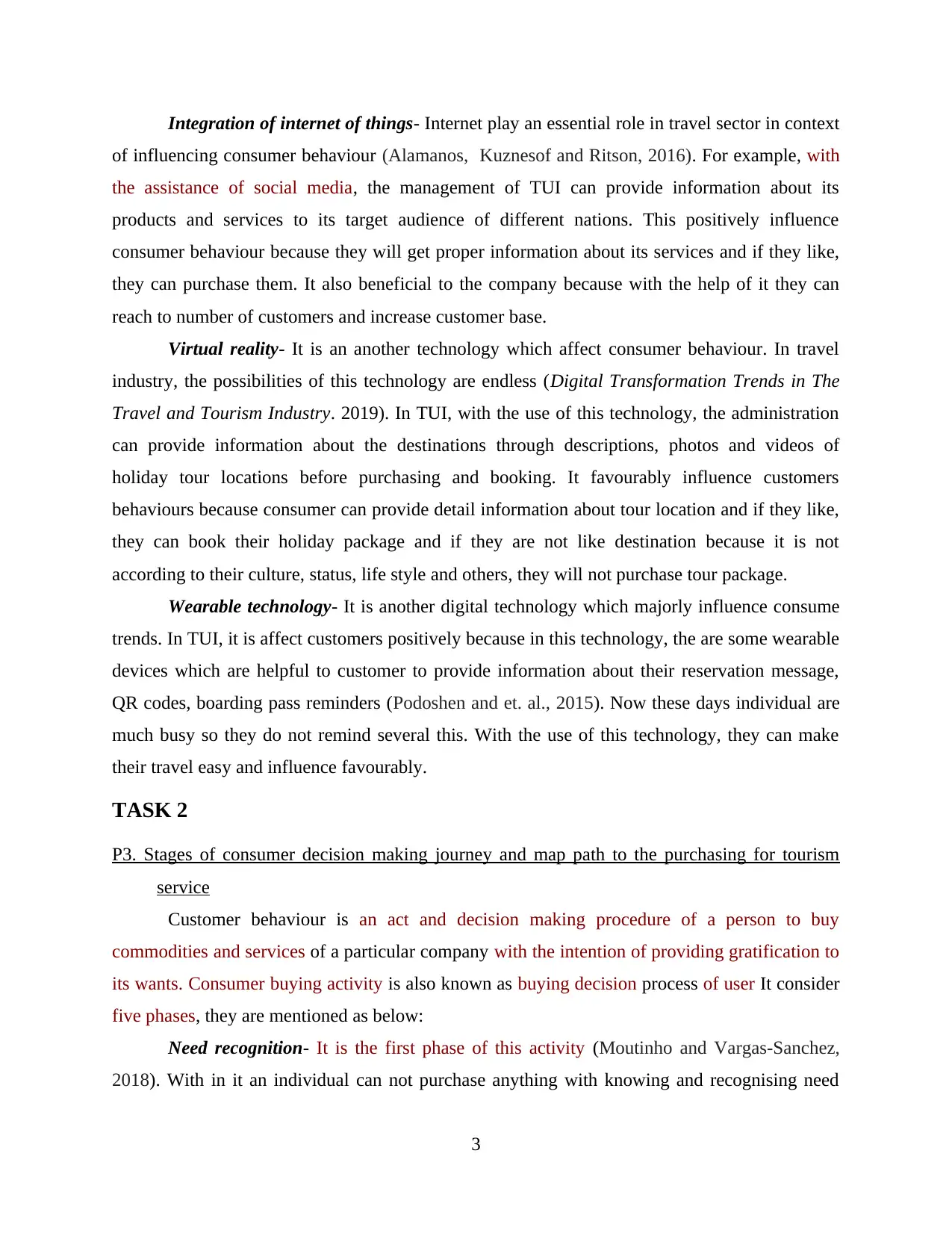
Integration of internet of things- Internet play an essential role in travel sector in context
of influencing consumer behaviour (Alamanos, Kuznesof and Ritson, 2016). For example, with
the assistance of social media, the management of TUI can provide information about its
products and services to its target audience of different nations. This positively influence
consumer behaviour because they will get proper information about its services and if they like,
they can purchase them. It also beneficial to the company because with the help of it they can
reach to number of customers and increase customer base.
Virtual reality- It is an another technology which affect consumer behaviour. In travel
industry, the possibilities of this technology are endless (Digital Transformation Trends in The
Travel and Tourism Industry. 2019). In TUI, with the use of this technology, the administration
can provide information about the destinations through descriptions, photos and videos of
holiday tour locations before purchasing and booking. It favourably influence customers
behaviours because consumer can provide detail information about tour location and if they like,
they can book their holiday package and if they are not like destination because it is not
according to their culture, status, life style and others, they will not purchase tour package.
Wearable technology- It is another digital technology which majorly influence consume
trends. In TUI, it is affect customers positively because in this technology, the are some wearable
devices which are helpful to customer to provide information about their reservation message,
QR codes, boarding pass reminders (Podoshen and et. al., 2015). Now these days individual are
much busy so they do not remind several this. With the use of this technology, they can make
their travel easy and influence favourably.
TASK 2
P3. Stages of consumer decision making journey and map path to the purchasing for tourism
service
Customer behaviour is an act and decision making procedure of a person to buy
commodities and services of a particular company with the intention of providing gratification to
its wants. Consumer buying activity is also known as buying decision process of user It consider
five phases, they are mentioned as below:
Need recognition- It is the first phase of this activity (Moutinho and Vargas-Sanchez,
2018). With in it an individual can not purchase anything with knowing and recognising need
3
of influencing consumer behaviour (Alamanos, Kuznesof and Ritson, 2016). For example, with
the assistance of social media, the management of TUI can provide information about its
products and services to its target audience of different nations. This positively influence
consumer behaviour because they will get proper information about its services and if they like,
they can purchase them. It also beneficial to the company because with the help of it they can
reach to number of customers and increase customer base.
Virtual reality- It is an another technology which affect consumer behaviour. In travel
industry, the possibilities of this technology are endless (Digital Transformation Trends in The
Travel and Tourism Industry. 2019). In TUI, with the use of this technology, the administration
can provide information about the destinations through descriptions, photos and videos of
holiday tour locations before purchasing and booking. It favourably influence customers
behaviours because consumer can provide detail information about tour location and if they like,
they can book their holiday package and if they are not like destination because it is not
according to their culture, status, life style and others, they will not purchase tour package.
Wearable technology- It is another digital technology which majorly influence consume
trends. In TUI, it is affect customers positively because in this technology, the are some wearable
devices which are helpful to customer to provide information about their reservation message,
QR codes, boarding pass reminders (Podoshen and et. al., 2015). Now these days individual are
much busy so they do not remind several this. With the use of this technology, they can make
their travel easy and influence favourably.
TASK 2
P3. Stages of consumer decision making journey and map path to the purchasing for tourism
service
Customer behaviour is an act and decision making procedure of a person to buy
commodities and services of a particular company with the intention of providing gratification to
its wants. Consumer buying activity is also known as buying decision process of user It consider
five phases, they are mentioned as below:
Need recognition- It is the first phase of this activity (Moutinho and Vargas-Sanchez,
2018). With in it an individual can not purchase anything with knowing and recognising need
3
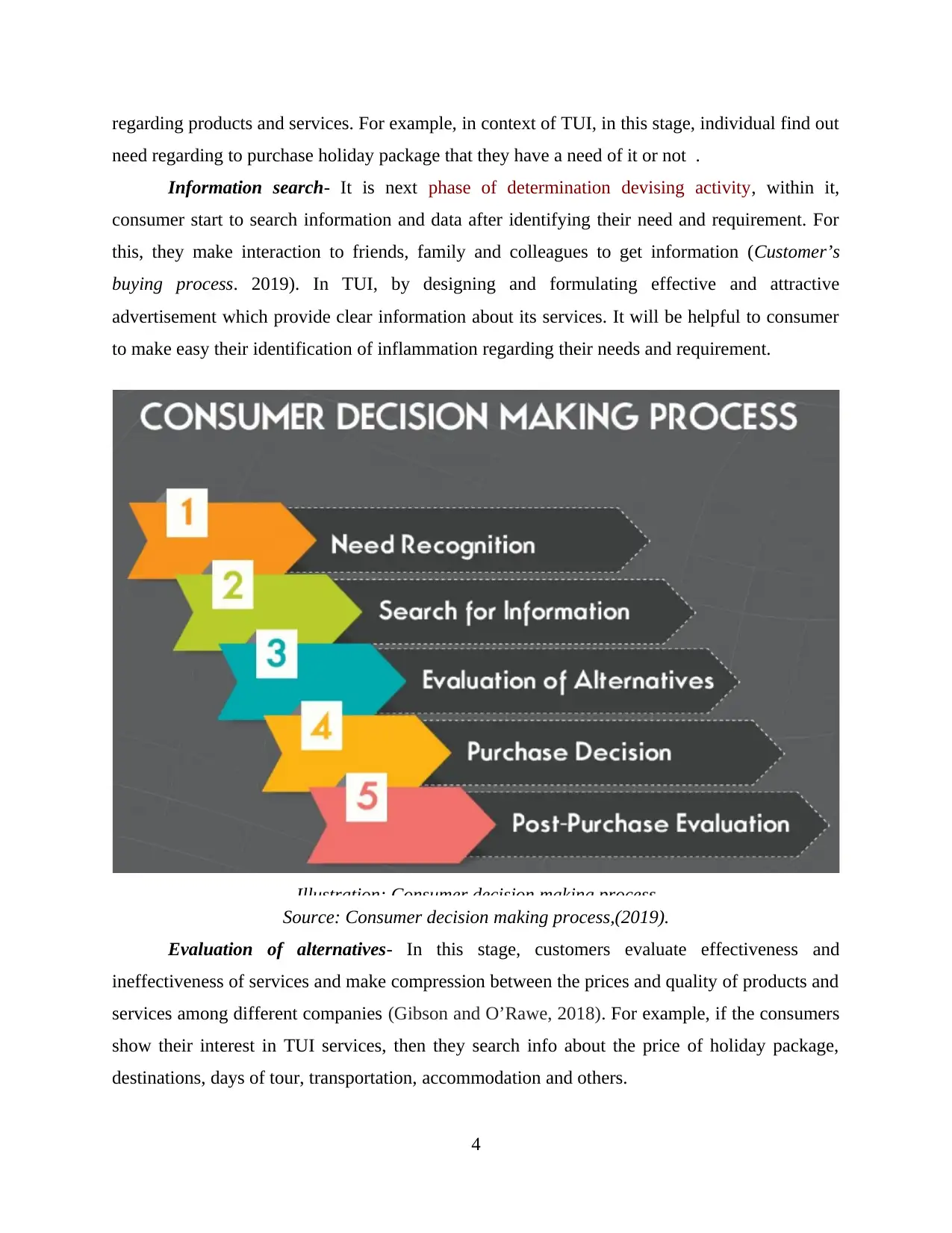
regarding products and services. For example, in context of TUI, in this stage, individual find out
need regarding to purchase holiday package that they have a need of it or not .
Information search- It is next phase of determination devising activity, within it,
consumer start to search information and data after identifying their need and requirement. For
this, they make interaction to friends, family and colleagues to get information (Customer’s
buying process. 2019). In TUI, by designing and formulating effective and attractive
advertisement which provide clear information about its services. It will be helpful to consumer
to make easy their identification of inflammation regarding their needs and requirement.
Source: Consumer decision making process,(2019).
Evaluation of alternatives- In this stage, customers evaluate effectiveness and
ineffectiveness of services and make compression between the prices and quality of products and
services among different companies (Gibson and O’Rawe, 2018). For example, if the consumers
show their interest in TUI services, then they search info about the price of holiday package,
destinations, days of tour, transportation, accommodation and others.
4
Illustration: Consumer decision making process
need regarding to purchase holiday package that they have a need of it or not .
Information search- It is next phase of determination devising activity, within it,
consumer start to search information and data after identifying their need and requirement. For
this, they make interaction to friends, family and colleagues to get information (Customer’s
buying process. 2019). In TUI, by designing and formulating effective and attractive
advertisement which provide clear information about its services. It will be helpful to consumer
to make easy their identification of inflammation regarding their needs and requirement.
Source: Consumer decision making process,(2019).
Evaluation of alternatives- In this stage, customers evaluate effectiveness and
ineffectiveness of services and make compression between the prices and quality of products and
services among different companies (Gibson and O’Rawe, 2018). For example, if the consumers
show their interest in TUI services, then they search info about the price of holiday package,
destinations, days of tour, transportation, accommodation and others.
4
Illustration: Consumer decision making process
⊘ This is a preview!⊘
Do you want full access?
Subscribe today to unlock all pages.

Trusted by 1+ million students worldwide
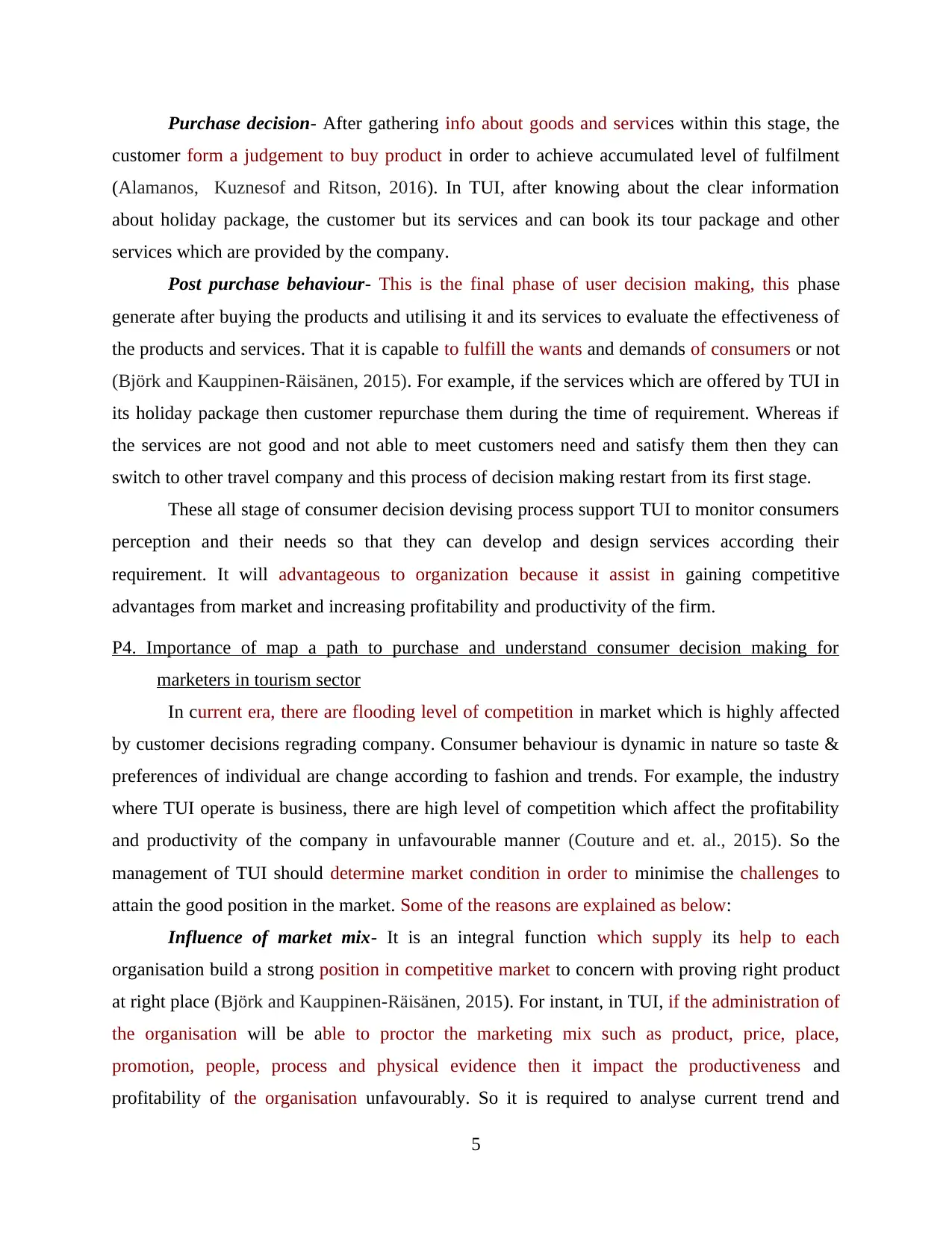
Purchase decision- After gathering info about goods and services within this stage, the
customer form a judgement to buy product in order to achieve accumulated level of fulfilment
(Alamanos, Kuznesof and Ritson, 2016). In TUI, after knowing about the clear information
about holiday package, the customer but its services and can book its tour package and other
services which are provided by the company.
Post purchase behaviour- This is the final phase of user decision making, this phase
generate after buying the products and utilising it and its services to evaluate the effectiveness of
the products and services. That it is capable to fulfill the wants and demands of consumers or not
(Björk and Kauppinen-Räisänen, 2015). For example, if the services which are offered by TUI in
its holiday package then customer repurchase them during the time of requirement. Whereas if
the services are not good and not able to meet customers need and satisfy them then they can
switch to other travel company and this process of decision making restart from its first stage.
These all stage of consumer decision devising process support TUI to monitor consumers
perception and their needs so that they can develop and design services according their
requirement. It will advantageous to organization because it assist in gaining competitive
advantages from market and increasing profitability and productivity of the firm.
P4. Importance of map a path to purchase and understand consumer decision making for
marketers in tourism sector
In current era, there are flooding level of competition in market which is highly affected
by customer decisions regrading company. Consumer behaviour is dynamic in nature so taste &
preferences of individual are change according to fashion and trends. For example, the industry
where TUI operate is business, there are high level of competition which affect the profitability
and productivity of the company in unfavourable manner (Couture and et. al., 2015). So the
management of TUI should determine market condition in order to minimise the challenges to
attain the good position in the market. Some of the reasons are explained as below:
Influence of market mix- It is an integral function which supply its help to each
organisation build a strong position in competitive market to concern with proving right product
at right place (Björk and Kauppinen-Räisänen, 2015). For instant, in TUI, if the administration of
the organisation will be able to proctor the marketing mix such as product, price, place,
promotion, people, process and physical evidence then it impact the productiveness and
profitability of the organisation unfavourably. So it is required to analyse current trend and
5
customer form a judgement to buy product in order to achieve accumulated level of fulfilment
(Alamanos, Kuznesof and Ritson, 2016). In TUI, after knowing about the clear information
about holiday package, the customer but its services and can book its tour package and other
services which are provided by the company.
Post purchase behaviour- This is the final phase of user decision making, this phase
generate after buying the products and utilising it and its services to evaluate the effectiveness of
the products and services. That it is capable to fulfill the wants and demands of consumers or not
(Björk and Kauppinen-Räisänen, 2015). For example, if the services which are offered by TUI in
its holiday package then customer repurchase them during the time of requirement. Whereas if
the services are not good and not able to meet customers need and satisfy them then they can
switch to other travel company and this process of decision making restart from its first stage.
These all stage of consumer decision devising process support TUI to monitor consumers
perception and their needs so that they can develop and design services according their
requirement. It will advantageous to organization because it assist in gaining competitive
advantages from market and increasing profitability and productivity of the firm.
P4. Importance of map a path to purchase and understand consumer decision making for
marketers in tourism sector
In current era, there are flooding level of competition in market which is highly affected
by customer decisions regrading company. Consumer behaviour is dynamic in nature so taste &
preferences of individual are change according to fashion and trends. For example, the industry
where TUI operate is business, there are high level of competition which affect the profitability
and productivity of the company in unfavourable manner (Couture and et. al., 2015). So the
management of TUI should determine market condition in order to minimise the challenges to
attain the good position in the market. Some of the reasons are explained as below:
Influence of market mix- It is an integral function which supply its help to each
organisation build a strong position in competitive market to concern with proving right product
at right place (Björk and Kauppinen-Räisänen, 2015). For instant, in TUI, if the administration of
the organisation will be able to proctor the marketing mix such as product, price, place,
promotion, people, process and physical evidence then it impact the productiveness and
profitability of the organisation unfavourably. So it is required to analyse current trend and
5
Paraphrase This Document
Need a fresh take? Get an instant paraphrase of this document with our AI Paraphraser
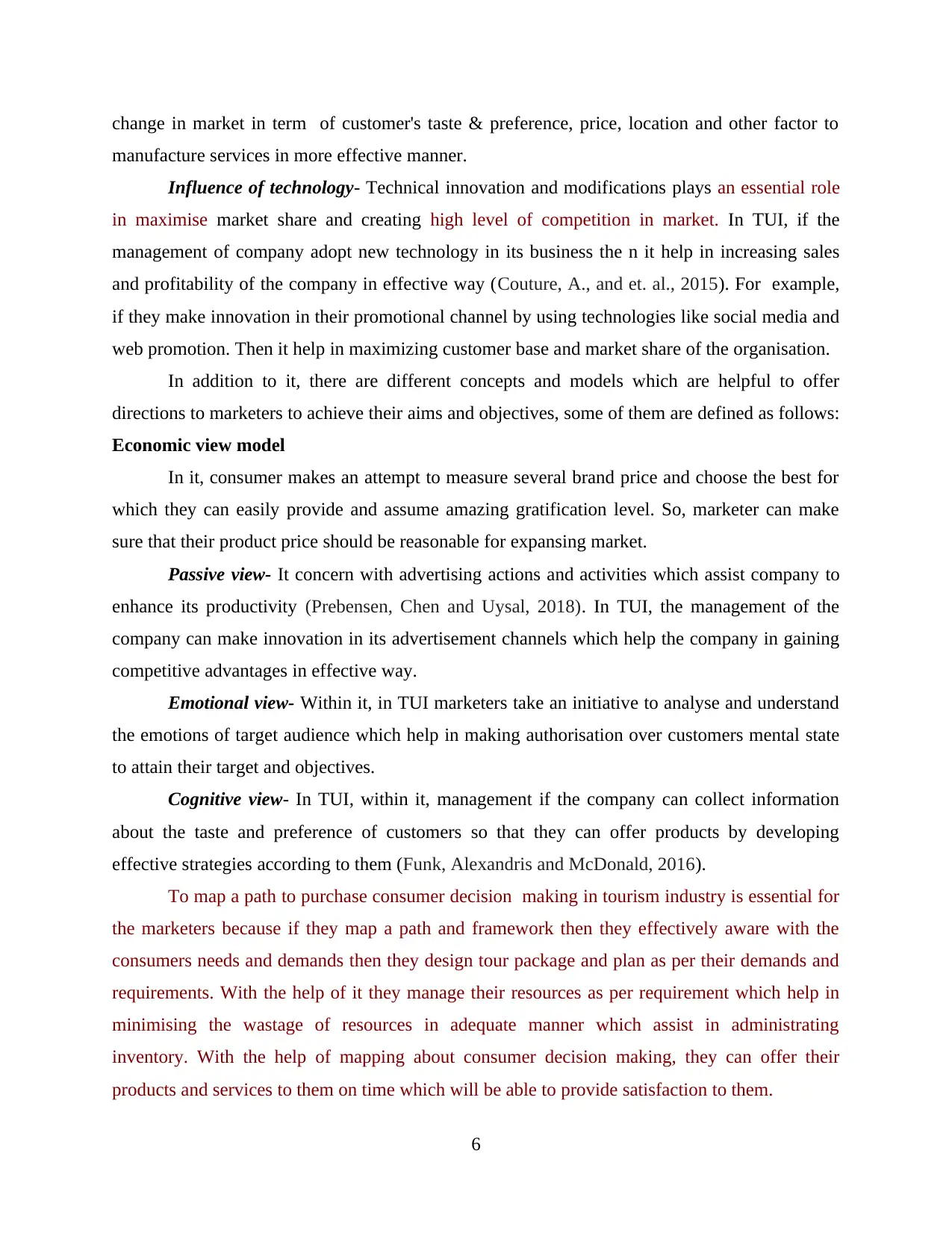
change in market in term of customer's taste & preference, price, location and other factor to
manufacture services in more effective manner.
Influence of technology- Technical innovation and modifications plays an essential role
in maximise market share and creating high level of competition in market. In TUI, if the
management of company adopt new technology in its business the n it help in increasing sales
and profitability of the company in effective way (Couture, A., and et. al., 2015). For example,
if they make innovation in their promotional channel by using technologies like social media and
web promotion. Then it help in maximizing customer base and market share of the organisation.
In addition to it, there are different concepts and models which are helpful to offer
directions to marketers to achieve their aims and objectives, some of them are defined as follows:
Economic view model
In it, consumer makes an attempt to measure several brand price and choose the best for
which they can easily provide and assume amazing gratification level. So, marketer can make
sure that their product price should be reasonable for expansing market.
Passive view- It concern with advertising actions and activities which assist company to
enhance its productivity (Prebensen, Chen and Uysal, 2018). In TUI, the management of the
company can make innovation in its advertisement channels which help the company in gaining
competitive advantages in effective way.
Emotional view- Within it, in TUI marketers take an initiative to analyse and understand
the emotions of target audience which help in making authorisation over customers mental state
to attain their target and objectives.
Cognitive view- In TUI, within it, management if the company can collect information
about the taste and preference of customers so that they can offer products by developing
effective strategies according to them (Funk, Alexandris and McDonald, 2016).
To map a path to purchase consumer decision making in tourism industry is essential for
the marketers because if they map a path and framework then they effectively aware with the
consumers needs and demands then they design tour package and plan as per their demands and
requirements. With the help of it they manage their resources as per requirement which help in
minimising the wastage of resources in adequate manner which assist in administrating
inventory. With the help of mapping about consumer decision making, they can offer their
products and services to them on time which will be able to provide satisfaction to them.
6
manufacture services in more effective manner.
Influence of technology- Technical innovation and modifications plays an essential role
in maximise market share and creating high level of competition in market. In TUI, if the
management of company adopt new technology in its business the n it help in increasing sales
and profitability of the company in effective way (Couture, A., and et. al., 2015). For example,
if they make innovation in their promotional channel by using technologies like social media and
web promotion. Then it help in maximizing customer base and market share of the organisation.
In addition to it, there are different concepts and models which are helpful to offer
directions to marketers to achieve their aims and objectives, some of them are defined as follows:
Economic view model
In it, consumer makes an attempt to measure several brand price and choose the best for
which they can easily provide and assume amazing gratification level. So, marketer can make
sure that their product price should be reasonable for expansing market.
Passive view- It concern with advertising actions and activities which assist company to
enhance its productivity (Prebensen, Chen and Uysal, 2018). In TUI, the management of the
company can make innovation in its advertisement channels which help the company in gaining
competitive advantages in effective way.
Emotional view- Within it, in TUI marketers take an initiative to analyse and understand
the emotions of target audience which help in making authorisation over customers mental state
to attain their target and objectives.
Cognitive view- In TUI, within it, management if the company can collect information
about the taste and preference of customers so that they can offer products by developing
effective strategies according to them (Funk, Alexandris and McDonald, 2016).
To map a path to purchase consumer decision making in tourism industry is essential for
the marketers because if they map a path and framework then they effectively aware with the
consumers needs and demands then they design tour package and plan as per their demands and
requirements. With the help of it they manage their resources as per requirement which help in
minimising the wastage of resources in adequate manner which assist in administrating
inventory. With the help of mapping about consumer decision making, they can offer their
products and services to them on time which will be able to provide satisfaction to them.
6
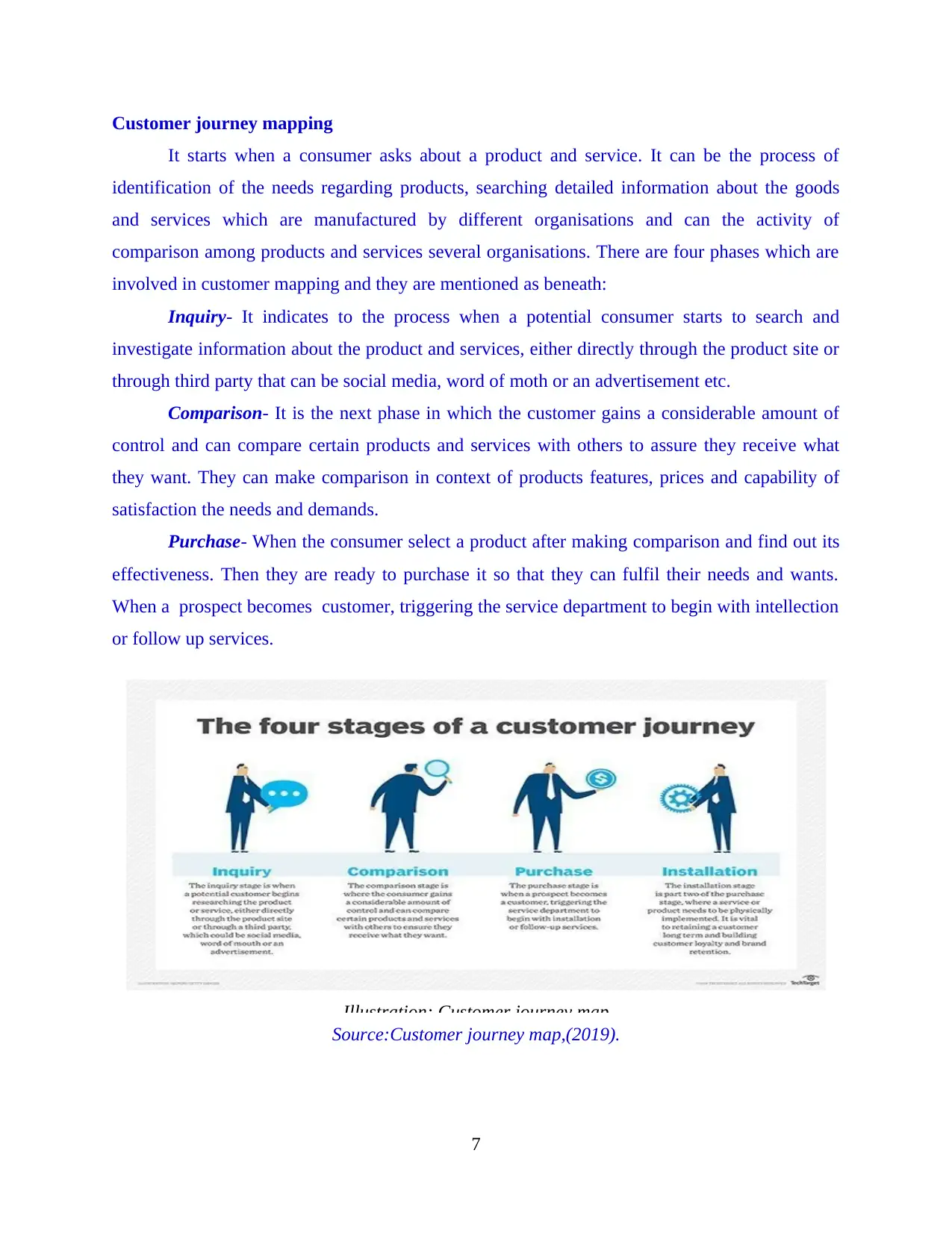
Customer journey mapping
It starts when a consumer asks about a product and service. It can be the process of
identification of the needs regarding products, searching detailed information about the goods
and services which are manufactured by different organisations and can the activity of
comparison among products and services several organisations. There are four phases which are
involved in customer mapping and they are mentioned as beneath:
Inquiry- It indicates to the process when a potential consumer starts to search and
investigate information about the product and services, either directly through the product site or
through third party that can be social media, word of moth or an advertisement etc.
Comparison- It is the next phase in which the customer gains a considerable amount of
control and can compare certain products and services with others to assure they receive what
they want. They can make comparison in context of products features, prices and capability of
satisfaction the needs and demands.
Purchase- When the consumer select a product after making comparison and find out its
effectiveness. Then they are ready to purchase it so that they can fulfil their needs and wants.
When a prospect becomes customer, triggering the service department to begin with intellection
or follow up services.
Source:Customer journey map,(2019).
7
Illustration: Customer journey map
It starts when a consumer asks about a product and service. It can be the process of
identification of the needs regarding products, searching detailed information about the goods
and services which are manufactured by different organisations and can the activity of
comparison among products and services several organisations. There are four phases which are
involved in customer mapping and they are mentioned as beneath:
Inquiry- It indicates to the process when a potential consumer starts to search and
investigate information about the product and services, either directly through the product site or
through third party that can be social media, word of moth or an advertisement etc.
Comparison- It is the next phase in which the customer gains a considerable amount of
control and can compare certain products and services with others to assure they receive what
they want. They can make comparison in context of products features, prices and capability of
satisfaction the needs and demands.
Purchase- When the consumer select a product after making comparison and find out its
effectiveness. Then they are ready to purchase it so that they can fulfil their needs and wants.
When a prospect becomes customer, triggering the service department to begin with intellection
or follow up services.
Source:Customer journey map,(2019).
7
Illustration: Customer journey map
⊘ This is a preview!⊘
Do you want full access?
Subscribe today to unlock all pages.

Trusted by 1+ million students worldwide
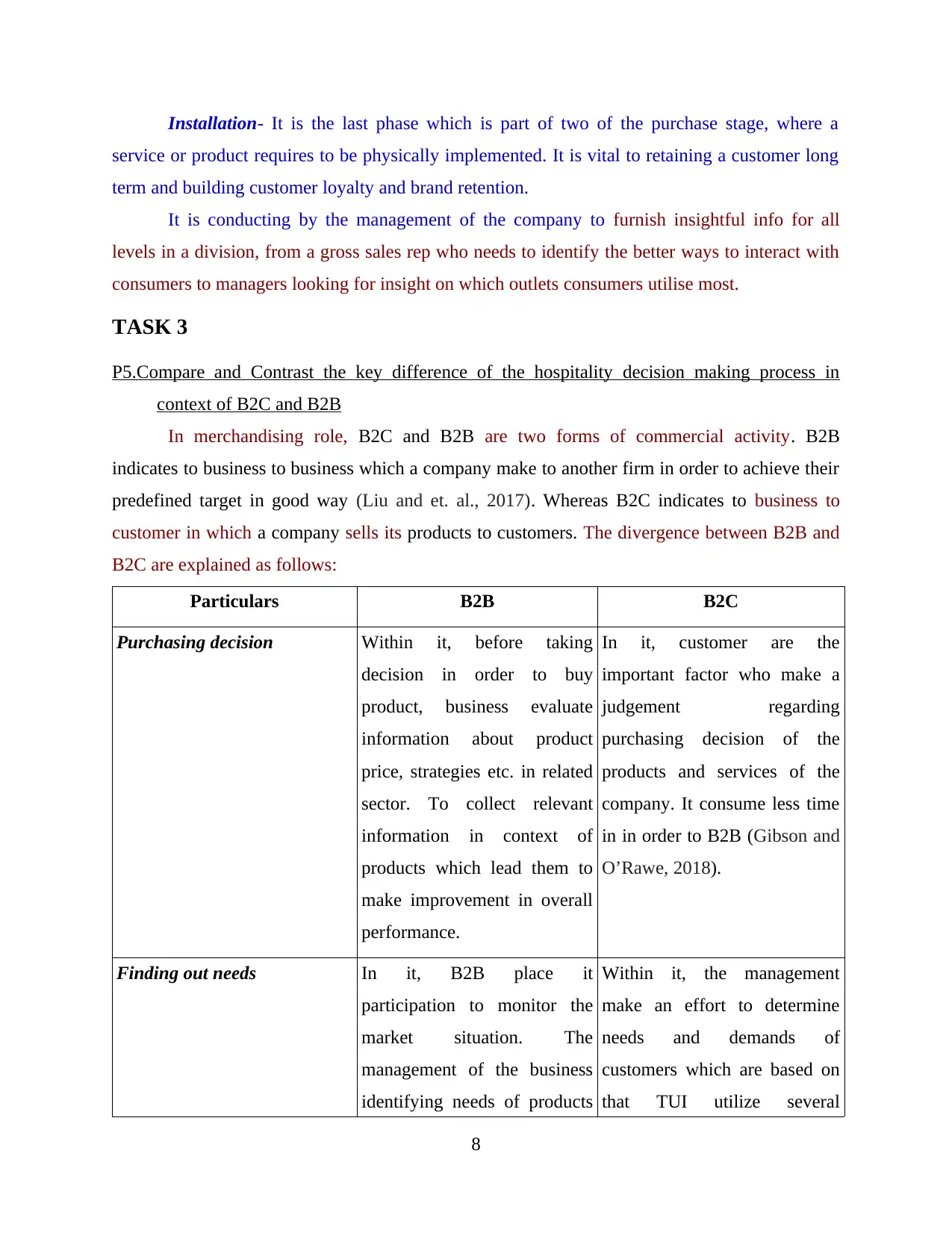
Installation- It is the last phase which is part of two of the purchase stage, where a
service or product requires to be physically implemented. It is vital to retaining a customer long
term and building customer loyalty and brand retention.
It is conducting by the management of the company to furnish insightful info for all
levels in a division, from a gross sales rep who needs to identify the better ways to interact with
consumers to managers looking for insight on which outlets consumers utilise most.
TASK 3
P5.Compare and Contrast the key difference of the hospitality decision making process in
context of B2C and B2B
In merchandising role, B2C and B2B are two forms of commercial activity. B2B
indicates to business to business which a company make to another firm in order to achieve their
predefined target in good way (Liu and et. al., 2017). Whereas B2C indicates to business to
customer in which a company sells its products to customers. The divergence between B2B and
B2C are explained as follows:
Particulars B2B B2C
Purchasing decision Within it, before taking
decision in order to buy
product, business evaluate
information about product
price, strategies etc. in related
sector. To collect relevant
information in context of
products which lead them to
make improvement in overall
performance.
In it, customer are the
important factor who make a
judgement regarding
purchasing decision of the
products and services of the
company. It consume less time
in in order to B2B (Gibson and
O’Rawe, 2018).
Finding out needs In it, B2B place it
participation to monitor the
market situation. The
management of the business
identifying needs of products
Within it, the management
make an effort to determine
needs and demands of
customers which are based on
that TUI utilize several
8
service or product requires to be physically implemented. It is vital to retaining a customer long
term and building customer loyalty and brand retention.
It is conducting by the management of the company to furnish insightful info for all
levels in a division, from a gross sales rep who needs to identify the better ways to interact with
consumers to managers looking for insight on which outlets consumers utilise most.
TASK 3
P5.Compare and Contrast the key difference of the hospitality decision making process in
context of B2C and B2B
In merchandising role, B2C and B2B are two forms of commercial activity. B2B
indicates to business to business which a company make to another firm in order to achieve their
predefined target in good way (Liu and et. al., 2017). Whereas B2C indicates to business to
customer in which a company sells its products to customers. The divergence between B2B and
B2C are explained as follows:
Particulars B2B B2C
Purchasing decision Within it, before taking
decision in order to buy
product, business evaluate
information about product
price, strategies etc. in related
sector. To collect relevant
information in context of
products which lead them to
make improvement in overall
performance.
In it, customer are the
important factor who make a
judgement regarding
purchasing decision of the
products and services of the
company. It consume less time
in in order to B2B (Gibson and
O’Rawe, 2018).
Finding out needs In it, B2B place it
participation to monitor the
market situation. The
management of the business
identifying needs of products
Within it, the management
make an effort to determine
needs and demands of
customers which are based on
that TUI utilize several
8
Paraphrase This Document
Need a fresh take? Get an instant paraphrase of this document with our AI Paraphraser
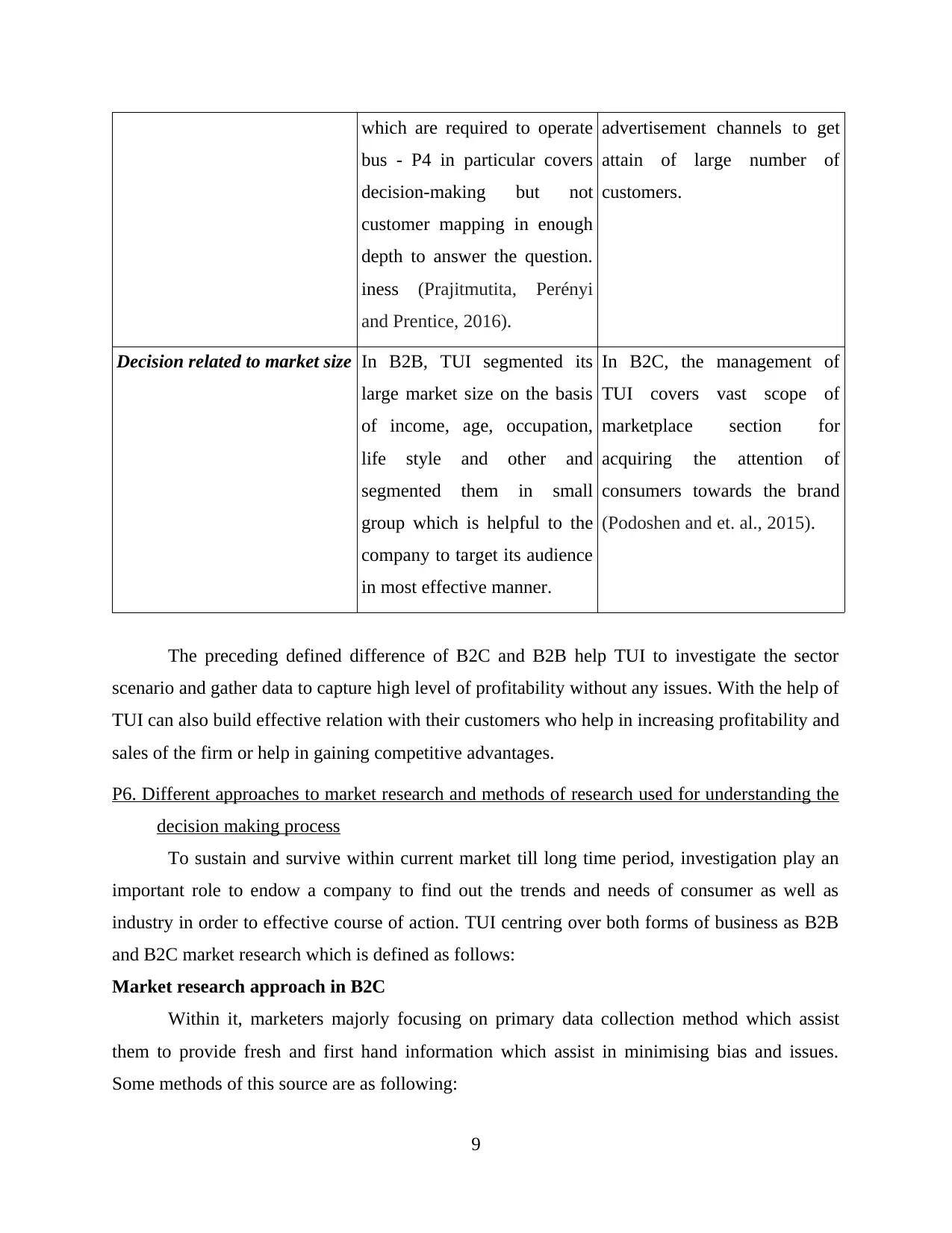
which are required to operate
bus - P4 in particular covers
decision-making but not
customer mapping in enough
depth to answer the question.
iness (Prajitmutita, Perényi
and Prentice, 2016).
advertisement channels to get
attain of large number of
customers.
Decision related to market size In B2B, TUI segmented its
large market size on the basis
of income, age, occupation,
life style and other and
segmented them in small
group which is helpful to the
company to target its audience
in most effective manner.
In B2C, the management of
TUI covers vast scope of
marketplace section for
acquiring the attention of
consumers towards the brand
(Podoshen and et. al., 2015).
The preceding defined difference of B2C and B2B help TUI to investigate the sector
scenario and gather data to capture high level of profitability without any issues. With the help of
TUI can also build effective relation with their customers who help in increasing profitability and
sales of the firm or help in gaining competitive advantages.
P6. Different approaches to market research and methods of research used for understanding the
decision making process
To sustain and survive within current market till long time period, investigation play an
important role to endow a company to find out the trends and needs of consumer as well as
industry in order to effective course of action. TUI centring over both forms of business as B2B
and B2C market research which is defined as follows:
Market research approach in B2C
Within it, marketers majorly focusing on primary data collection method which assist
them to provide fresh and first hand information which assist in minimising bias and issues.
Some methods of this source are as following:
9
bus - P4 in particular covers
decision-making but not
customer mapping in enough
depth to answer the question.
iness (Prajitmutita, Perényi
and Prentice, 2016).
advertisement channels to get
attain of large number of
customers.
Decision related to market size In B2B, TUI segmented its
large market size on the basis
of income, age, occupation,
life style and other and
segmented them in small
group which is helpful to the
company to target its audience
in most effective manner.
In B2C, the management of
TUI covers vast scope of
marketplace section for
acquiring the attention of
consumers towards the brand
(Podoshen and et. al., 2015).
The preceding defined difference of B2C and B2B help TUI to investigate the sector
scenario and gather data to capture high level of profitability without any issues. With the help of
TUI can also build effective relation with their customers who help in increasing profitability and
sales of the firm or help in gaining competitive advantages.
P6. Different approaches to market research and methods of research used for understanding the
decision making process
To sustain and survive within current market till long time period, investigation play an
important role to endow a company to find out the trends and needs of consumer as well as
industry in order to effective course of action. TUI centring over both forms of business as B2B
and B2C market research which is defined as follows:
Market research approach in B2C
Within it, marketers majorly focusing on primary data collection method which assist
them to provide fresh and first hand information which assist in minimising bias and issues.
Some methods of this source are as following:
9
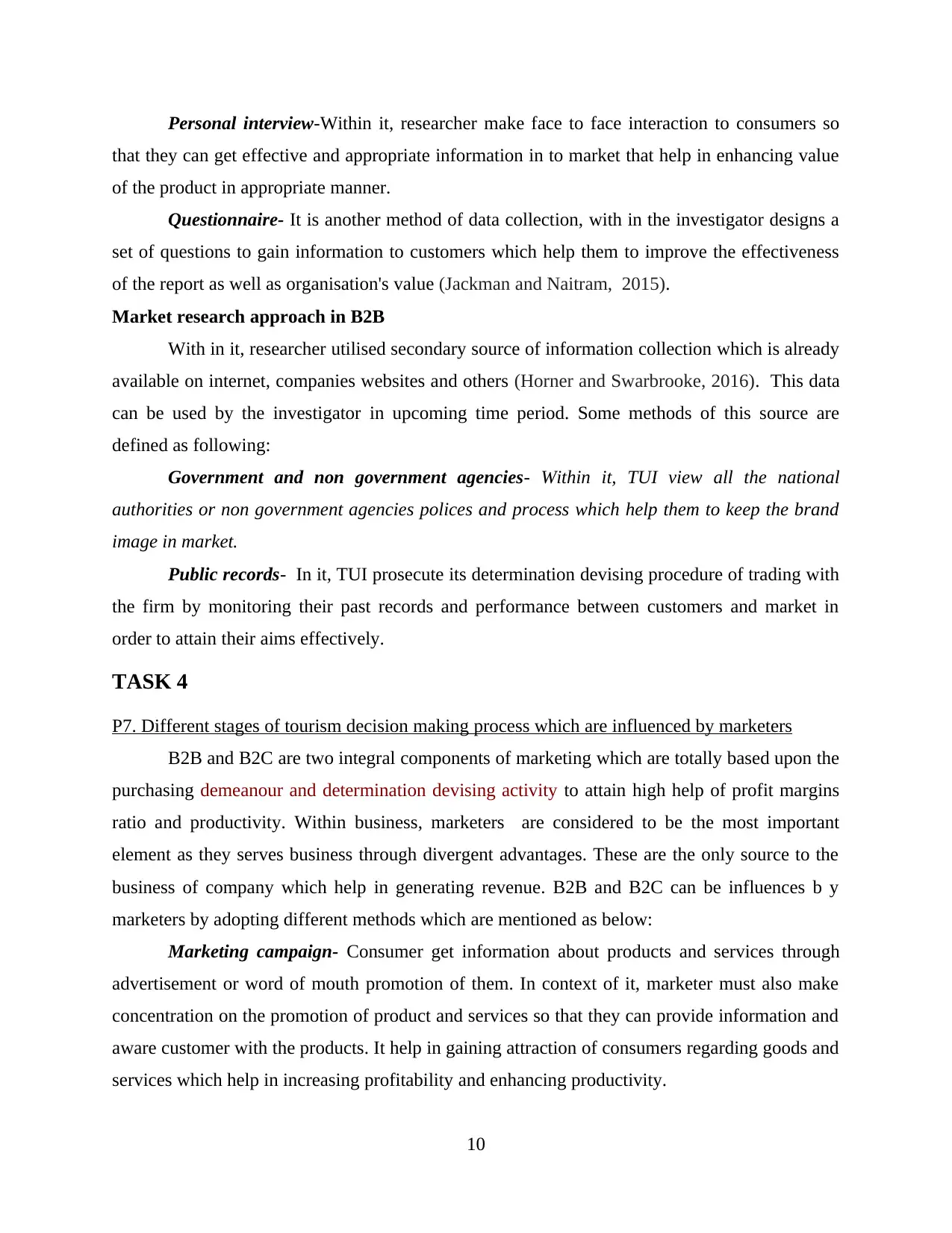
Personal interview-Within it, researcher make face to face interaction to consumers so
that they can get effective and appropriate information in to market that help in enhancing value
of the product in appropriate manner.
Questionnaire- It is another method of data collection, with in the investigator designs a
set of questions to gain information to customers which help them to improve the effectiveness
of the report as well as organisation's value (Jackman and Naitram, 2015).
Market research approach in B2B
With in it, researcher utilised secondary source of information collection which is already
available on internet, companies websites and others (Horner and Swarbrooke, 2016). This data
can be used by the investigator in upcoming time period. Some methods of this source are
defined as following:
Government and non government agencies- Within it, TUI view all the national
authorities or non government agencies polices and process which help them to keep the brand
image in market.
Public records- In it, TUI prosecute its determination devising procedure of trading with
the firm by monitoring their past records and performance between customers and market in
order to attain their aims effectively.
TASK 4
P7. Different stages of tourism decision making process which are influenced by marketers
B2B and B2C are two integral components of marketing which are totally based upon the
purchasing demeanour and determination devising activity to attain high help of profit margins
ratio and productivity. Within business, marketers are considered to be the most important
element as they serves business through divergent advantages. These are the only source to the
business of company which help in generating revenue. B2B and B2C can be influences b y
marketers by adopting different methods which are mentioned as below:
Marketing campaign- Consumer get information about products and services through
advertisement or word of mouth promotion of them. In context of it, marketer must also make
concentration on the promotion of product and services so that they can provide information and
aware customer with the products. It help in gaining attraction of consumers regarding goods and
services which help in increasing profitability and enhancing productivity.
10
that they can get effective and appropriate information in to market that help in enhancing value
of the product in appropriate manner.
Questionnaire- It is another method of data collection, with in the investigator designs a
set of questions to gain information to customers which help them to improve the effectiveness
of the report as well as organisation's value (Jackman and Naitram, 2015).
Market research approach in B2B
With in it, researcher utilised secondary source of information collection which is already
available on internet, companies websites and others (Horner and Swarbrooke, 2016). This data
can be used by the investigator in upcoming time period. Some methods of this source are
defined as following:
Government and non government agencies- Within it, TUI view all the national
authorities or non government agencies polices and process which help them to keep the brand
image in market.
Public records- In it, TUI prosecute its determination devising procedure of trading with
the firm by monitoring their past records and performance between customers and market in
order to attain their aims effectively.
TASK 4
P7. Different stages of tourism decision making process which are influenced by marketers
B2B and B2C are two integral components of marketing which are totally based upon the
purchasing demeanour and determination devising activity to attain high help of profit margins
ratio and productivity. Within business, marketers are considered to be the most important
element as they serves business through divergent advantages. These are the only source to the
business of company which help in generating revenue. B2B and B2C can be influences b y
marketers by adopting different methods which are mentioned as below:
Marketing campaign- Consumer get information about products and services through
advertisement or word of mouth promotion of them. In context of it, marketer must also make
concentration on the promotion of product and services so that they can provide information and
aware customer with the products. It help in gaining attraction of consumers regarding goods and
services which help in increasing profitability and enhancing productivity.
10
⊘ This is a preview!⊘
Do you want full access?
Subscribe today to unlock all pages.

Trusted by 1+ million students worldwide
1 out of 15
Related Documents
Your All-in-One AI-Powered Toolkit for Academic Success.
+13062052269
info@desklib.com
Available 24*7 on WhatsApp / Email
![[object Object]](/_next/static/media/star-bottom.7253800d.svg)
Unlock your academic potential
Copyright © 2020–2025 A2Z Services. All Rights Reserved. Developed and managed by ZUCOL.




